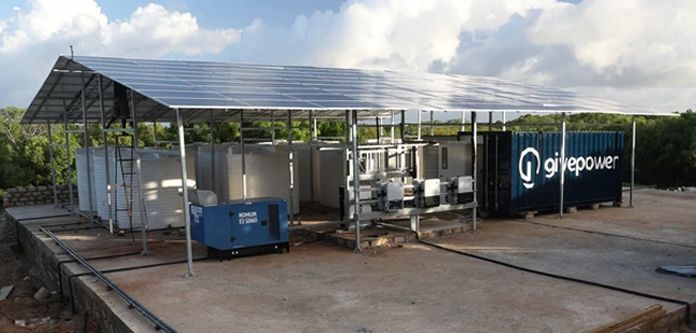Solar-powered Desalination Plant Turning Salt Water to Drinking Water in Kenya
Published on by Herman Kyle, Editor at Pumps Africa News in Technology
With advanced filtration systems and new solar-powered desalination technology, GivePower is converting sea and brackish salt water into clean and healthy water.

GivePower water solar desalination in Kiunga, Kenya (Image source: Pumps Africa)
Solar-powered desalination plant constructed by GivePower is turning sea water to fresh water in the coastal area of Kiunga in Kenya.
The newly constructed facility in Kenya is tackling the drinking water challenge using solar power, and can produce 75,000 liters of fresh drinking water per day, enough for 25,000 people.
With advanced filtration systems and new solar-powered desalination technology, GivePower is converting sea and brackish salt water into clean and healthy water. The kiunga facility took one month to construct at a cost of US$ 500,000.
Hayes Barnard, the founder and president of GivePower, says Humanity needs to take swift action to address the increasingly severe global water crisis that faces the developing world.
“With our background in off-grid clean energy, GivePower can immediately help by deploying solar water farm solutions to save lives in areas throughout the world that suffer from prolonged water scarcity,” he says.
According to UNICEF, WHO report on inequalities in access to water, sanitation and hygiene, 1 in 3 people globally do not have access to safe drinking water. The report reveals that 1.8 billion people have gained access to basic drinking water services since 2000, but there are vast inequalities in the accessibility, availability and quality of these services.
GivePower started as a nonprofit branch of solar-panel company, SolarCity in 2013, but it spun-off before SolarCity merged with Tesla in 2016 to focus on building solar-energy systems that provide electricity across the developing world.
The NGO has installed solar grids in over 2,650 locations primarily in schools, medical clinics, and villages across 17 countries.
Desalination technology is not cheap since it uses high-power pumps and consumes a lot of energy, therefore, Barnard envisions smaller, modular-style solar desalination units that would use a single pump and a 15-kilowatt solar grid with three Tesla batteries.
Read more about this project on The water Network:
Introducing GivePower: Solar-powered System Treats Clean Drinking Water for 25,000 People per Day
Media
Taxonomy
- Water
- Treatment
- Technology
- Energy
- Desalination
- Water Supply
8 Comments
-
contact details? Alli 27 72 481 3057
-
Very good solution and I would like invest and install.How to proceed?
1 Comment reply
-
Dear Soloman Prince you can contact - Hayes BARNARD on hayes@givepower.org
-
-
75,000 liters / 25,000 = 3 liters / person
around 17.24 kW/lps, plus ? kW of sw pumping to RO station
-
What is the KW/Cubic meter ratio they achieve in the desalination process?
-
Would supply 25,000 people, but strictly DRINKING water. Not for washing, cooking etc.
-
Does not supply 25,000 people... a lot less...
1 Comment reply
-
The newly constructed facility is tackling the drinking water challenge - 75,000 litres per day supplied to 25,000 people would be about 3 litres of drinking water per person/day.
-
-
This is an interesting solution and most appropriate for tropical countries which have sunlight more than 10Hrs per day.
-
MED and distillation done under vacuum can bring in better efficiency and lower power consumption.
Well wishes.